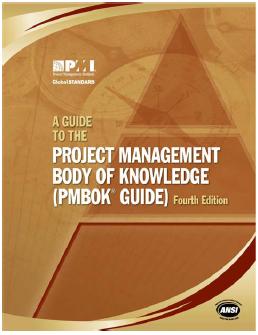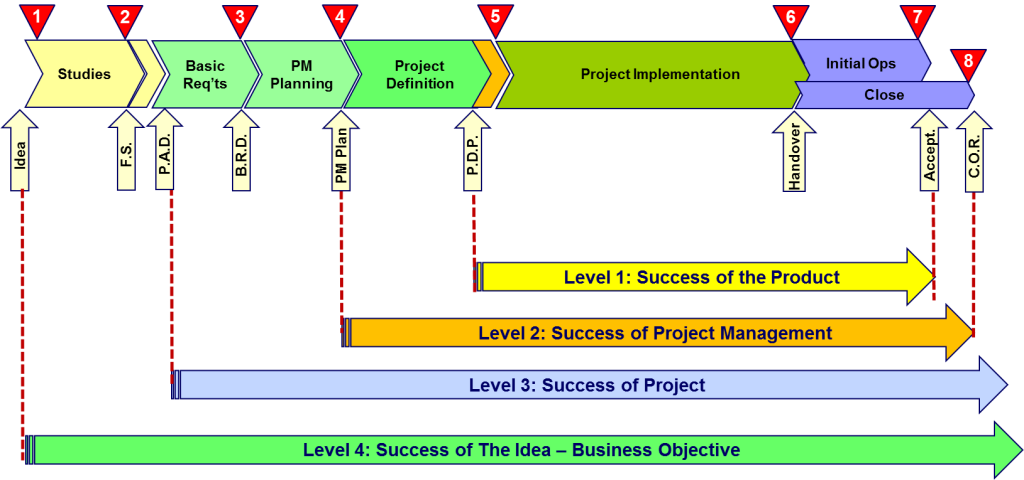This is the fourth and last article in a four-article series on the subject of project success. Article 1 was mostly an introduction to the subject; article 2 was explaining the four dimensions; article 3 provided an example, real case study, and this article, compares the application of this concept to PMBOK® Guide.
Background
In November of 2012, the author was invited as one of the keynote speakers at the PMI Lebanon Chapter first annual conference, we chose this subject – but the presentation time was about 25 minutes only. The audience was a mix of experienced professionals, students, managers, project managers, and PMPs.
During the presentation, a few attendees challenged what we presented. Later in the day, we understood that the presentation created a debate – some liking what we offered, and others thought we were wrong … and gave comments like:
- “Not aligned to the PMBOK® Guide”,
- “If I deliver the product on time and budget – this is success”,
- “The PMBOK defined the project complete with acceptance”,
- “This is not project management”,
- “The project manager is not responsible for this”,
- Many other similar comments.
Some of the comments came from professionals who work for service providers.
We must stress here that not all of these comments are wrong. Possibly, only the first one is wrong, and what we will address here. The second and third items are not wrong but are only partially correct; please refer to our prior posts. The last two raise a point but read on.
The Four Dimensions
We do not want to repeat the last three posts but only want to remind the reader that the four dimensions are from the organizational perspective, where the organization is the project owner and not service provider.
The Link to the PMBOK® Guide
Understanding the PMBOK
 We will be direct here – the problems we observe today, in the world of project management, are:
We will be direct here – the problems we observe today, in the world of project management, are:
- Some practitioners, and PMPs, use the PMBOK® Guide as a holy book; not realizing that like any other standard or approach, it is not complete and it is not meant to be stand alone
- Some practitioners do not fully understand the PMBOK® Guide; they might know the process groups but miss the big picture
- If the PMBOK® Guide does not explicitly say something, that does anything from outside the PMBOK then it must be wrong
- Even PMI realizes that there are something called “general alignment” to cover topics that align in principle but may offer more than what the PMBOK is mandated to offer
Alignment to PMBOK
Having said that, then how does the model we present aligns with the PMBOK® Guide?
- The four dimensions are per the SUKAD Customizable and Adaptable Methodology for Managing Projects™. The PMBOK® says that the guide, itself is NOT a methodology. One can use, ANY, methodology to supplement it … CAM2P™ is a methodology that supplement the PMBOK® Guide.
- The PMBOK Guide discusses that organizations perform projects based on a business need, and they do so since the organization expect to realize some benefits, be it commercial gain or social good.
- The PMBOK Guide discusses projects objectives and include them in the charter
Unfortunately, the PMBOK does not stress how to measure project success, beyond the first two dimensions.[special note – now that the 5th edition of the PMBOK is out the situation is worst — it is too complicated to explain here so we will write an article based on the latest change] So back to point 3 (from understanding the PMBOK), if the PMBOK does not explicitly discuss the four dimensions, it mostly certainly implies them, or at least does not exclude accepting them. The PMBOK talks about project success, selection criteria, benefits realization, and more … so how to assess those?
More Information
The following is from a response on a similar topic on a LinkedIn group. In this case, the specific comment was mostly about the project has a start and an end and our third and fourth dimensions goes beyond the end defined by PMI.
We agree that the project has start and end; this is why we have a project life span. Therefore, the questions are:
- Where is the start
- Where is the end
- From whose perspective are we viewing this question?
The PMBOK defines the start with the charter; the end with project acceptance and closure. The difficult one to answer from the PMBOK perspective, is the third question, whose perspective? We did answer this question in the first article of the series.
As we already presented here, the PMBOK discusses that organizations do projects because they expect benefits.
- In business, we do projects for money (ROI, or any other measurement)
- In government, we do projects for citizens
- In not-for-profit, we do projects for social good
- In all of these cases, there is something that drives the project — expected benefits.
The PMBOK discusses we launch projects because we expect benefits but does not discuss, at least effectively, when and how we measure benefits realization.
Examples
A not-for-profit launches a project to build a community center. What is the project?
If we take the narrow view – some would think the project is the community center, and this is all we care about it. So success is completion of the center. This might be true for the contractor or the project manager but not for the NGO.
The NGO (the organization) did not build the center for show – they built the center for an expected benefit to the community – meaning – people using and benefiting from the center. Consequently, success would be (a) center is built, and (b) people are using it —
To formalize the above, we need success criteria.
If 10 people use the center, is that success? How about 100, 1000 …? No one can say unless you have defined that early … So if, one say “we expect 1000 people to use the center” but only 100 actually uses it, then the project did not succeed (objective not met).
In other words, organizations build facilities and plants, develop applications, re-organize, not for the sake of building, or developing, but to REALIZE BENEFITS. The project is only the first step, and the mechanism to help the organization realize the benefits – this is the strategic view.
We take the view that:
- Projects are strategic change agents within organizations …
- Projects are for a purpose that must align to organizational objective
- Projects are developed by owners (buyers) – of course some service providers could be doing the detailed work, but the objective is what the owner want
- For a buyer – there are benefits — and success criteria — with criteria not limited to budget, cost, and functionality
We want to hear from you, your thoughts, counter points, or any other point you might have.
As promised earlier, the following are links to:
- The chapter on project success from our forthcoming book and eBook series
- A presentation on the subject, expanded on the one we delivered at the PMI Conference

